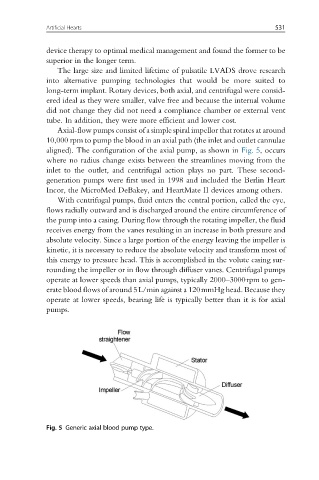Page 537 - Handbook of Biomechatronics
P. 537
Artificial Hearts 531
device therapy to optimal medical management and found the former to be
superior in the longer term.
The large size and limited lifetime of pulsatile LVADS drove research
into alternative pumping technologies that would be more suited to
long-term implant. Rotary devices, both axial, and centrifugal were consid-
ered ideal as they were smaller, valve free and because the internal volume
did not change they did not need a compliance chamber or external vent
tube. In addition, they were more efficient and lower cost.
Axial-flow pumps consist of a simple spiral impellor that rotates at around
10,000 rpm to pump the blood in an axial path (the inlet and outlet cannulae
aligned). The configuration of the axial pump, as shown in Fig. 5, occurs
where no radius change exists between the streamlines moving from the
inlet to the outlet, and centrifugal action plays no part. These second-
generation pumps were first used in 1998 and included the Berlin Heart
Incor, the MicroMed DeBakey, and HeartMate II devices among others.
With centrifugal pumps, fluid enters the central portion, called the eye,
flows radially outward and is discharged around the entire circumference of
the pump into a casing. During flow through the rotating impeller, the fluid
receives energy from the vanes resulting in an increase in both pressure and
absolute velocity. Since a large portion of the energy leaving the impeller is
kinetic, it is necessary to reduce the absolute velocity and transform most of
this energy to pressure head. This is accomplished in the volute casing sur-
rounding the impeller or in flow through diffuser vanes. Centrifugal pumps
operate at lower speeds than axial pumps, typically 2000–3000rpm to gen-
erate blood flows of around 5L/min against a 120mmHg head. Because they
operate at lower speeds, bearing life is typically better than it is for axial
pumps.
Fig. 5 Generic axial blood pump type.

